FIND THE AREA OF THE SHADED REGION
Subscribe to our ▶️ YouTube channel 🔴 for the latest videos, updates, and tips.
Find the area of shaded regions :
Example 1 :
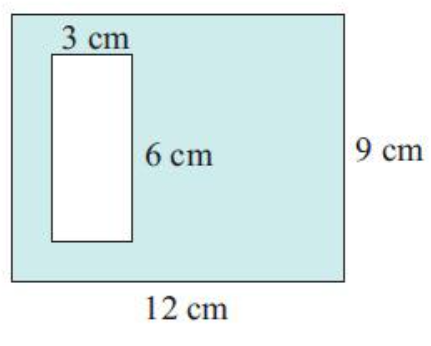
Solution :
Area of shaded region
= Area of large rectangle – Area of small rectangle
Area of rectangle = Length ⋅ width
Large rectangle :
Length = 12 cm
width = 9 cm
Area of large rectangle = (12 ⋅ 9)
= 108 cm2------(1)
Small rectangle :
Length = 6 cm
width = 3 cm
Area of small rectangle = (6 ⋅ 3)
= 18 cm2------(2)
(1) – (2)
= (108 – 18) cm2
= 90 cm2
So, area of shaded region is 90 cm2
Example 2 :

Solution :
Area of shaded region
= Area of rectangle – 2(Area of triangle)
Area of rectangle = length ⋅ width
Area of triangle = (1/2) ⋅ base ⋅ height
Area of rectangle :
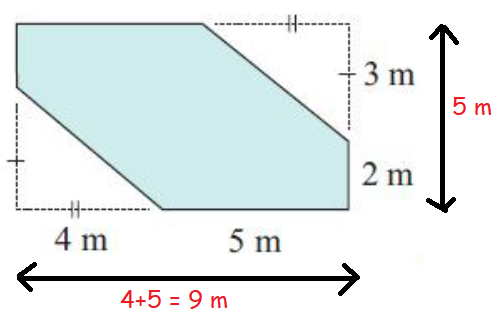
Area of rectangle = (9 ⋅ 5)
= 45 m2------(1)
2(Area of triangle) :
base = 4 m
height = 3 m
2(Area of triangle) = 2(1/2) ⋅ 4 ⋅ 3
= 2(6)
= 12 m2------(2)
(1) – (2)
Area of shaded region = (45 – 12) m2
= 33 m2
So, area of shaded region is 33 m2
Example 3 :
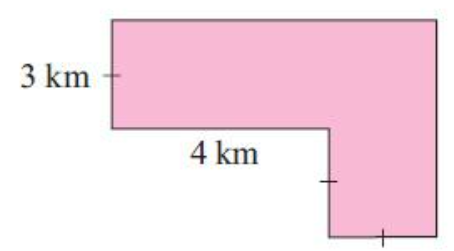
Solution :
Area of shaded region
= Area of rectangle + Area of square
Area of rectangle :
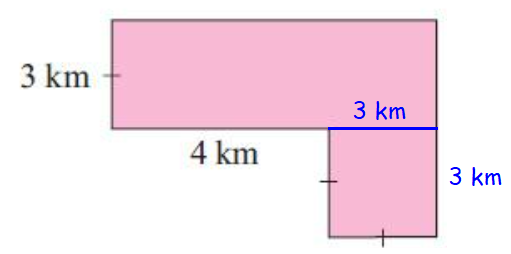
Length = (4 + 3) km ==> 7 km
Width = 3 km
Area of rectangle = (7 ⋅ 3)
= 21 km2-----(1)
Area of square :
side = 3 km
Area of square = (side)2 = (3)2
= 9 km2-----(2)
(1) + (2)
= (21 + 9) km2
Area of shaded region = 30 km2
So, area of shaded region is 30 km2
Example 4 :
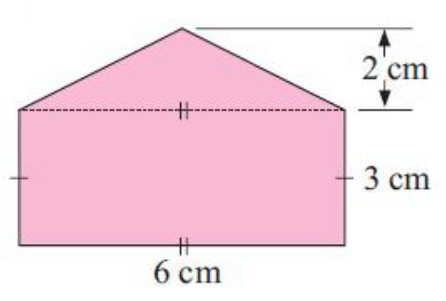
Solution :
Area of shaded region
= Area of triangle + Area of rectangle
Area of triangle :
Area of triangle = (1/2) ⋅ base ⋅ height
base = 6 cm and height = 2 cm
Area of triangle = (1/2 ⋅ 6 ⋅ 2)
= 6 cm2-----(1)
Area of rectangle :
Area of rectangle = Length . width
Length = 6 cm and Width = 3 cm
Area of rectangle = (6 ⋅ 3)
= 18 cm2-----(2)
(1) + (2)
Area of shaded region = (6 + 18) cm2
= 24 cm2
So, area of shaded region is 24 cm2
Example 5 :
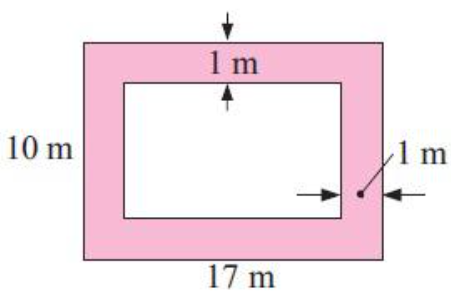
Solution :
Area of shaded region
= Area of large rectangle – Area of small rectangle
Area of rectangle = Length ⋅ width
Large rectangle :
Length = 17 m and width = 10 m
Area of large rectangle = (17 ⋅ 10)
= 170 m2------(1)
Small rectangle :
Length = (17–2) ==> 15 m
width = (10–2) ==> 8 m
Area of small rectangle = (15 ⋅ 8)
= 120 m2------(2)
(1) – (2)
= (170 – 120) m2
= 50 m2
So, area of shaded region is 50 m2
Example 6 :
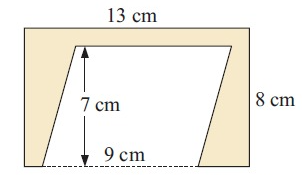
Solution :
Area of shaded region
= Area of rectangle – Area of parallelogram
Area of parallelogram = base ⋅ height
Area of rectangle :
Area of rectangle = Length ⋅ width
Length = 13 cm and width = 8 cm
Area of rectangle = (13 ⋅ 8)
= 104 cm2-----(1)
Area of parallelogram :
base = 9 cm and height = 7 cm
Area of parallelogram = (9 ⋅ 7)
= 63 cm2------(2)
(1) – (2)
= (104 – 63) cm2
Area of shaded region = 41 cm2
So, area of shaded region is 41 cm2
Example 7 :
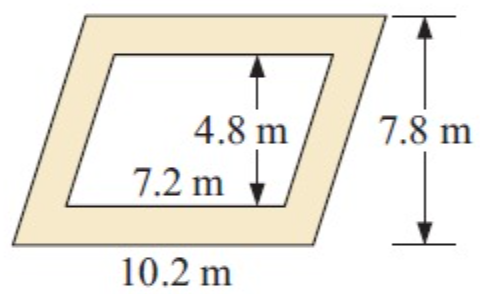
Solution :
Area of shaded region
= Area of large parallelogram – Area of small parallelogram
Large parallelogram :
base = 10.2 m and height = 7.8 m
Area of large parallelogram = (10.2 × 7.8)
= 79.56 m2------(1)
Small parallelogram :
base = 7.2 m and height = 4.8 m
Area of small parallelogram = (7.2 × 4.8)
= 34.56 m2------(2)
(1) – (2)
= (79.56 – 34.56) m2
= 45 m2
So, area of shaded region is 45 m2
Example 8 :
A rectangular lawn 18 m by 30 m is surrounded by a concrete path 1 m wide. Draw a diagram of the situation and find the total area of concrete.
Solution :
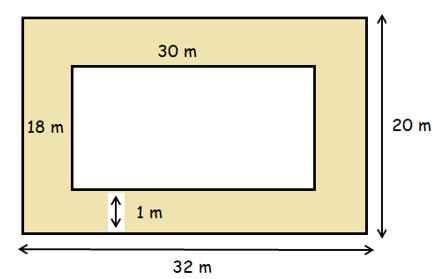
Area of shaded region
= Area of rectangular concrete path – Area of rectangular lawn
Area of rectangle = Length . width
Area of rectangular concrete path :
Length = (30+2) m ==> 32 m
width = (18+2) m ==> 20 m
Area of rectangular concrete path = (32 . 20)
= 640 m2------(1)
Area of rectangular lawn :
Length = 30 m and width = 18 m
Area of rectangular lawn = (30 . 18)
= 540 m2------(2)
(1) – (2)
= (640 – 540) m2
= 100 m2
So, total area of concrete is 100 m2
Example 9 :
The shaded square is inscribed the larger square
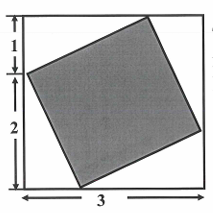
Solution :
Since the given shape is a square and at each corner we see right triangles. Each right triangle should satisfy Pythagorean theorem also,
22 + 12 = (Side length of square)2
4 + 1 = (Side length of square)2
(Side length of square)2 = 5
Area of square = side length x side length
So, area of the shaded square is 5 square units.
Example 10 :
The figure consists of 2 concentric circles. If the shaded area is The shaded circle is 64 π and the smaller circle has the radius of 6 cm, what is the radius of the larger circle in inches ?
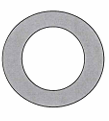
Solution :
Let R and r be the radius of larger circle and smaller circle respectively.
Area of shaded circle = Area of larger circle - area of smaller circle
= πR2 - π r2
πR2 - π r2 = 64π
R2 - r2 = 64
Here r = 6
R2 - 62 = 64
R2 = 64 + 36
R2 = 100
R = 10
So, radius of larger circle is 10 cm.
Subscribe to our ▶️ YouTube channel 🔴 for the latest videos, updates, and tips.
Kindly mail your feedback to v4formath@gmail.com
We always appreciate your feedback.
About Us | Contact Us | Privacy Policy
©All rights reserved. onlinemath4all.com
Recent Articles
-
Digital SAT Math Problems and Solutions (Part - 13)
Dec 18, 25 12:26 PM
Digital SAT Math Problems and Solutions (Part - 13) -
90 Degree Clockwise Rotation
Dec 18, 25 09:42 AM
90 Degree Clockwise Rotation - Rule - Examples with step by step explanation -
10 Hard SAT Math Questions (Part - 40)
Dec 18, 25 08:49 AM
10 Hard SAT Math Questions (Part - 40)

